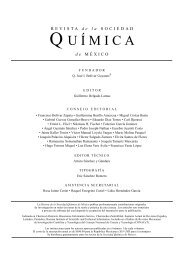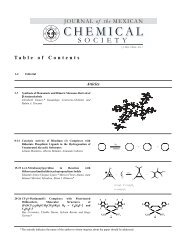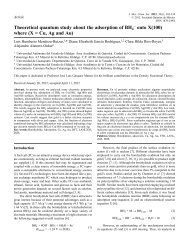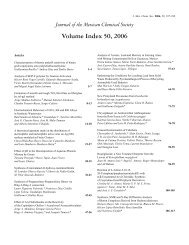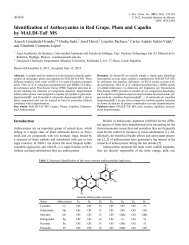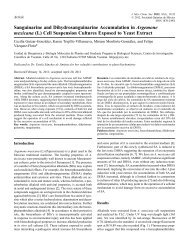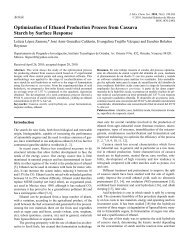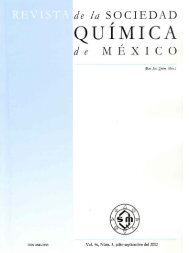Pincer Complexes. Applications in Catalysis
Pincer Complexes. Applications in Catalysis
Pincer Complexes. Applications in Catalysis
You also want an ePaper? Increase the reach of your titles
YUMPU automatically turns print PDFs into web optimized ePapers that Google loves.
342 Rev. Soc. Quím. Méx. 2004, 48 David Morales-Morales<br />
tion temperature the system do not match the performance of<br />
the complexes 13 and 14, nor <strong>in</strong> yield of the term<strong>in</strong>al olef<strong>in</strong> or<br />
<strong>in</strong> the turnover numbers previously discussed.<br />
Hydrogen Transfer Reactions<br />
van Koten and coworkers have employed successfully ruthenium<br />
NCN (17) and PCP (18) p<strong>in</strong>cer complexes to perform<br />
hydrogen transfer reactions to reduce ketones to their correspond<strong>in</strong>g<br />
alcohols us<strong>in</strong>g iso-propanol as source of hydrogen<br />
and KOH as co-catalyst [28].<br />
Although both complexes are active catalysts <strong>in</strong> this<br />
process, the best yields and turnover numbers where obta<strong>in</strong>ed<br />
with the PCP p<strong>in</strong>cer derivatives, for <strong>in</strong>stance, for cyclohexanone,<br />
under reflux conditions, yields of 98% and turnover<br />
numbers of 27,000 were obta<strong>in</strong>ed, be<strong>in</strong>g these numbers the<br />
best so far obta<strong>in</strong>ed, compared with mono phosph<strong>in</strong>e ruthenium<br />
complexes like [RuCl 2(PPh 3)] or [RuCl(H)(PPh 3)] [29].<br />
Given these results, several attempts have been done with the<br />
aim of <strong>in</strong>terpolate this process to obta<strong>in</strong> enantiomerically pure<br />
alcohols, among these the use of chiral ruthenium PCP p<strong>in</strong>cer<br />
complexes (19) [30]. However, despite of the fact that com-<br />
plex 19 exhibits catalytic activity comparable to the non-chiral<br />
counterparts, the reaction of iso-PrOH and acetophenone only<br />
affords 14% ee [31].<br />
Aldolic Condensations<br />
The synthesis of enantiomerically pure oxazol<strong>in</strong>es can be conveniently<br />
done through the gold catalyzed [32] aldolic condensation<br />
reactions between an aldehyde or a ketone with an isocyanate.<br />
These compounds are very important, s<strong>in</strong>ce the consecutive<br />
hydrolysis of the oxazol<strong>in</strong>es obta<strong>in</strong>ed by this procedure,<br />
offers a simple and efficient route for the synthesis of βhydroxyam<strong>in</strong>oacids.<br />
It is noteworthy that the first enantiomerically pure PCP<br />
p<strong>in</strong>cer complexes were evaluated <strong>in</strong> this process. Venanzi and<br />
coworkers [33] designed these compounds by <strong>in</strong>troduc<strong>in</strong>g chiral<br />
acetals <strong>in</strong> the benzylic positions of the PCP ligands, the<br />
reaction be<strong>in</strong>g achieved by the Sharpless type enantioselective<br />
epoxydation.<br />
The plat<strong>in</strong>um derivative of this ligand (20) has shown to<br />
be active <strong>in</strong> the asymmetric aldolic addition of methyl-α-isocyanoacetate<br />
with aldehydes to yield moderated enantiomeric<br />
yields of 32% and 65% ee for the correspond<strong>in</strong>g cis and trans<br />
oxazol<strong>in</strong>es respectively. This reaction is carried out <strong>in</strong> the<br />
presence of a base that acts as cocatalyst for the formation of<br />
the metal-isocyanoenolate <strong>in</strong>termediate (21).





